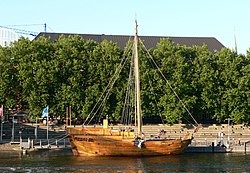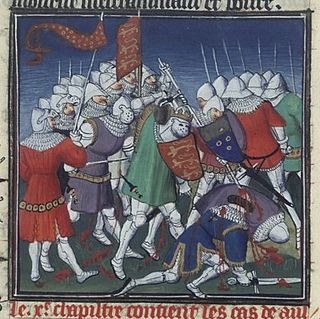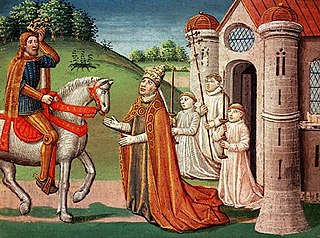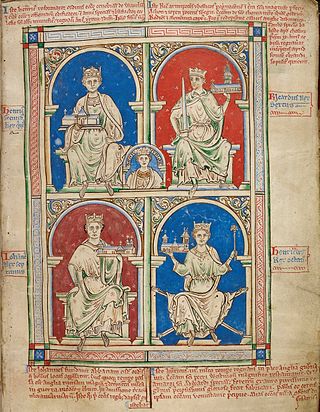
In the Middle Ages, boats were used to transport horses over long distances, both for war and for trade. They can be found from the Early Middle Ages, in Celtic, Germanic and Mediterranean traditions.

In the Middle Ages, boats were used to transport horses over long distances, both for war and for trade. They can be found from the Early Middle Ages, in Celtic, Germanic and Mediterranean traditions.

The Romans had developed efficient methods of sea transport for horses, which were improved by the Arabic nations in the Early Middle Ages; these transports became common in Europe from the tenth century. [1] Horse transports could be powered by oars, or sometimes by sail.
The oared tarida was able to be loaded and unloaded directly on a beach, using doors as loading ramps. [2] In 1174 an Italo-Norman force attacked Alexandria with 1,500 horses transported on 36 tarides. [3] Detailed specifications for thirteenth century tarides exist, showing they could carry 20 to 30 horses. In Angevin tarides, horses were stalled in threes, supported by canvas slings. Genoese tarides in 1246 carried 150 water butts containing 39,750 litres in total. [4]
Sailing transports, known as usciere in Italian (French huissiers; Latin usserii), were also built. These had two decks and could carry up to 100 horses. The horses were loaded through openings in the hull, which were then sealed for the voyage. Venetian usciere built for Louis IX in 1268 were 25.76 m long, had a beam of 6.1 m, had two decks and two masts. [5]

Records of cavalry transportation abound throughout the period, reflecting the changes in warfare. For example, the Scandinavians had adapted the horse-transport technology by the 12th century as part of their move away from the traditional Viking infantry. [6] The first illustration displaying such horse-transport in western Europe can be found in the Bayeux Tapestry's depiction of the Norman conquest of England. [7] This particular military venture required the transfer of over 2,000 horses from Normandy. [8] Scholars have linked the successful use of horse transports during the Norman conquest of England to Norman interactions with Byzantines (who had mastered horse transportation in amphibious operations) in Southern Italy in the 11th century. [9] [10]
The small size of many transport vessels available and the need to carry fodder and water on all but the shortest journeys restricted the number of horses that could be carried. Records from the 13th century show a range from 8 to 20 horses. [11] In 1303 ships transporting horses between Scotland and Ireland carried between 10 and 32 animals. [12]
Adapting a ship for horse transportation required the installation of stalls of wood or hurdles. Detailed records of the fitting of an English fleet of 1340 show the creation of 418 hurdles, 413 iron rings and staples, canvas mangers and the creation of four gangways for loading 30 feet long by 5 wide. Similar records from 1338 show 47 ships were equipped with 134 tuns to carry water for horses. [13] Whether English vessels used canvas slings to support the horses like contemporary Mediterranean practice is uncertain. Military historian Michael Prestwich speculates they did [14] and he is supported by naval historian Ian Friel, who believes that the references to canvas mangers referred to above should actually be translated as canvas slings. [15]
The development and building of horse transports for use in war meant it remained easy to transfer horses for breeding and purchase during peacetime. After William of Normandy's successful conquest of England, he continued to bring horses across from Normandy for breeding purposes, improving the bloodstock of the English horses. [8] By the time of the Hundred Years' War, the English government banned the export of horses in times of crisis. [16]


Medieval warfare is the warfare of the Middle Ages. Technological, cultural, and social advancements had forced a severe transformation in the character of warfare from antiquity, changing military tactics and the role of cavalry and artillery. In terms of fortification, the Middle Ages saw the emergence of the castle in Europe, which then spread to the Holy Land.

A trireme was an ancient vessel and a type of galley that was used by the ancient maritime civilizations of the Mediterranean Sea, especially the Phoenicians, ancient Greeks and Romans.

The Battle of Hastings was fought on 14 October 1066 between the Norman-French army of William, the Duke of Normandy, and an English army under the Anglo-Saxon King Harold Godwinson, beginning the Norman Conquest of England. It took place approximately 7 mi (11 km) northwest of Hastings, close to the present-day town of Battle, East Sussex, and was a decisive Norman victory.

The Bayeux Tapestry is an embroidered cloth nearly 70 metres long and 50 centimetres tall that depicts the events leading up to the Norman Conquest of England in 1066, led by William, Duke of Normandy challenging Harold II, King of England, and culminating in the Battle of Hastings. It is thought to date to the 11th century, within a few years of the battle. Now widely accepted to have been made in England perhaps as a gift for William, it tells the story from the point of view of the conquering Normans and for centuries has been preserved in Normandy.

The Battle of Crécy took place on 26 August 1346 in northern France between a French army commanded by King Philip VI and an English army led by King Edward III. The French attacked the English while they were traversing northern France during the Hundred Years' War, resulting in an English victory and heavy loss of life among the French.

Odo of Bayeux was Bishop of Bayeux in Normandy, and was also made Earl of Kent in England following the Norman Conquest. He was the maternal half-brother of duke, and later king, William the Conqueror, and was, for a time, William's primary administrator in the Kingdom of England, although he was eventually tried for defrauding the William's government. It is likely Odo commissioned the Bayeux Tapestry a large tableau of the Norman Conquest, perhaps to present to his brother William. He later fell out with his brother over Odo's support for military adventures in Italy. William, on his deathbed, freed Odo. Odo died in Palermo Sicily on the way to crusade.

The Battle of Sluys, also called the Battle of l'Écluse, was a naval battle fought on 24 June 1340 between England and France. It took place in the roadstead of the port of Sluys, on a since silted-up inlet between Zeeland and West Flanders. The English fleet of 120–150 ships was led by Edward III of England and the 230-strong French fleet by the Breton knight Hugues Quiéret, Admiral of France, and Nicolas Béhuchet, Constable of France. The battle was one of the opening engagements of the Hundred Years' War.

The Battle of Tinchebray took place on 28 September 1106, in Tinchebray, Normandy, between an invading force led by King Henry I of England, and the Norman army of his elder brother Robert Curthose, the Duke of Normandy. Henry's knights won a decisive victory: they captured Robert, and Henry imprisoned him in England and then in Wales until Robert's death in 1134.

A cog was a type of ship that was used during the Middle Ages, mostly for trade and transport but also in war. It first appeared in the 10th century, and was widely used from around the 12th century on. Cogs were clinker-built, generally of oak. Cogs were fitted with a single mast and a single square sail. They were used primarily for trade in north-west medieval Europe, especially by the Hanseatic League. Typical seagoing cogs were from 15 to 25 meters long, 5 to 8 meters wide, and were of 30–200 tons burthen. Cogs were rarely as large as 300 tons although a few were considerably larger, over 1,000 tons.

England in the Middle Ages concerns the history of England during the medieval period, from the end of the 5th century through to the start of the early modern period in 1485. When England emerged from the collapse of the Roman Empire, the economy was in tatters and many of the towns abandoned. After several centuries of Germanic immigration, new identities and cultures began to emerge, developing into kingdoms that competed for power. A rich artistic culture flourished under the Anglo-Saxons, producing epic poems such as Beowulf and sophisticated metalwork. The Anglo-Saxons converted to Christianity in the 7th century, and a network of monasteries and convents were built across England. In the 8th and 9th centuries, England faced fierce Viking attacks, and the fighting lasted for many decades. Eventually, Wessex was established as the most powerful kingdom and promoted the growth of an English identity. Despite repeated crises of succession and a Danish seizure of power at the start of the 11th century, it can also be argued that by the 1060s England was a powerful, centralised state with a strong military and successful economy.

Early thermal weapons, which used heat or burning action to destroy or damage enemy personnel, fortifications or territories, were employed in warfare during the classical and medieval periods.

A dromon was a type of galley and the most important warship of the Byzantine navy from the 5th to 12th centuries AD, when they were succeeded by Italian-style galleys. It was developed from the ancient liburnian, which was the mainstay of the Roman navy during the Empire.

A galley was a type of ship which relied mostly on oars for propulsion that was used for warfare, trade, and piracy mostly in the seas surrounding Europe. It developed in the Mediterranean world during antiquity and continued to exist in various forms until the early 19th century. It typically had a long, slender hull, shallow draft, and often a low freeboard. Most types of galleys also had sails that could be used in favourable winds, but they relied primarily on oars to move independently of winds and currents. The term "galley" originated from a Greek term for a small type of galley and came in use in English from about 1300. It has occasionally been used for unrelated vessels with similar military functions as galley but which were not Mediterranean in origin, such as medieval Scandinavian longships, 16th-century Acehnese ghalis and 18th-century North American gunboats.

The Byzantine navy was the naval force of the Byzantine Empire. Like the state it served, it was a direct continuation from its Roman predecessor, but played a far greater role in the defence and survival of the state than its earlier iteration. While the fleets of the Roman Empire faced few great naval threats, operating as a policing force vastly inferior in power and prestige to the army, command of the sea became vital to the very existence of the Byzantine state, which several historians have called a "maritime empire".

The destrier is the best-known war horse of the Middle Ages. It carried knights in battles, tournaments, and jousts. It was described by contemporary sources as the Great Horse, due to its significance.

The first evidence of horses in warfare dates from Eurasia between 4000 and 3000 BC. A Sumerian illustration of warfare from 2500 BC depicts some type of equine pulling wagons. By 1600 BC, improved harness and chariot designs made chariot warfare common throughout the Ancient Near East, and the earliest written training manual for war horses was a guide for training chariot horses written about 1350 BC. As formal cavalry tactics replaced the chariot, so did new training methods, and by 360 BC, the Greek cavalry officer Xenophon had written an extensive treatise on horsemanship. The effectiveness of horses in battle was also revolutionized by improvements in technology, such as the invention of the saddle, the stirrup, and the horse collar.

The Battle of Caen was an assault conducted on 26 July 1346 by forces from the Kingdom of England, led by King Edward III, on the French-held town of Caen and Normandy as a part of the Hundred Years' War.
Medieval ships were the vessels used in Europe during the Middle Ages. Like ships from antiquity, they were moved by sails, oars, or a combination of the two. There was a large variety, mostly based on much older, conservative designs. Although wider and more frequent communications within Europe meant exposure to a variety of improvements, experimental failures were costly and rarely attempted. Ships in the north were influenced by Viking vessels, while those in the south by classical or Roman vessels. However, there was technological change. The different traditions used different construction methods; clinker in the north, carvel in the south. By the end of the period, carvel construction would come to dominate the building of large ships. The period would also see a shift from the steering oar or side rudder to the stern rudder and the development from single-masted to multi-masted ships. As the area is connected by water, people in the Mediterranean built different kinds of ships to accommodate different sea levels and climates. Within the Mediterranean area during the Medieval times ships were used for a multitude of reasons, like war, trade, and exploration.

Horses in the Middle Ages differed in size, build and breed from the modern horse, and were, on average, smaller. They were also more central to society than their modern counterparts, being essential for war, agriculture, and transport.

In the history of England, the High Middle Ages spanned the period from the Norman Conquest in 1066 to the death of King John, considered by some historians to be the last Angevin king of England, in 1216. A disputed succession and victory at the Battle of Hastings led to the conquest of England by William of Normandy in 1066. This linked the Kingdom of England with Norman possessions in the Kingdom of France and brought a new aristocracy to the country that dominated landholding, government and the church. They brought with them the French language and maintained their rule through a system of castles and the introduction of a feudal system of landholding. By the time of William's death in 1087, England formed the largest part of an Anglo-Norman empire, ruled by nobles with landholdings across England, Normandy and Wales. William's sons disputed succession to his lands, with William II emerging as ruler of England and much of Normandy. On his death in 1100 his younger brother claimed the throne as Henry I and defeated his brother Robert to reunite England and Normandy. Henry was a ruthless yet effective king, but after the death of his only male heir William Adelin, he persuaded his barons to recognise his daughter Matilda as heir. When Henry died in 1135 her cousin Stephen of Blois had himself proclaimed king, leading to a civil war known as The Anarchy. Eventually Stephen recognised Matilda's son Henry as his heir and when Stephen died in 1154, he succeeded as Henry II.